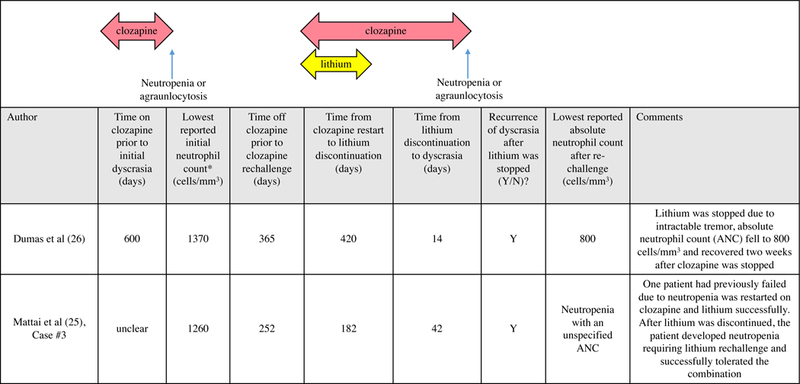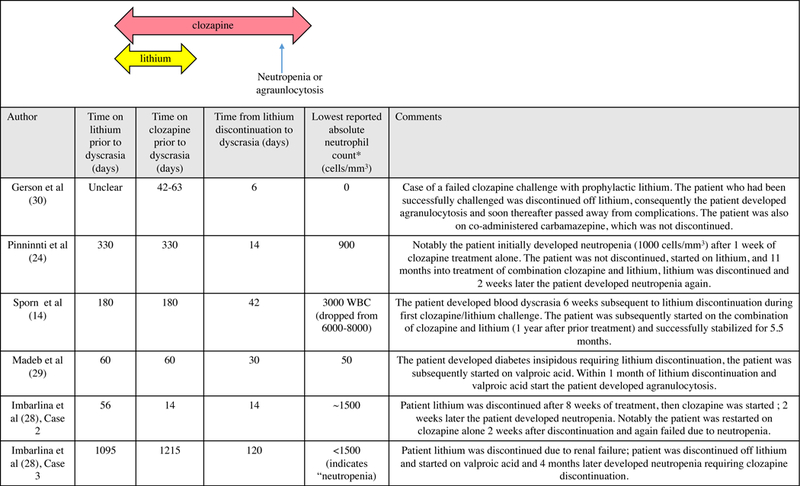To the Editor:
Neutropenia (defined as an absolute neutrophil count <1500 cells/mm3) occurs in 3–5% 1, 2 of individuals on clozapine, and agranulocytosis (defined as an ANC <500 cells/mm3) occurs in 0.38–0.81% 3, 4. To mitigate the risk of recurrent dyscrasias, lithium and/or granulocyte colony-stimulating factor have been added when clozapine is restarted 5–8. In a systematic review, Manu et al reported that 94% (33/35) of successful clozapine rechallenges included lithium augmentation. Though lithium may on average increase ANC by 88% of baseline values 9, little is known about the long-term need for lithium after clozapine rechallenge, especially given known side effects. Do individuals develop neutropenia or agranulocytosis after lithium is discontinued?
METHODS:
We conducted a PubMed search up to December 10, 2017 using the MESH terms “clozapine” AND “lithium” AND “neutropenia” OR “agranulocytosis”.
RESULTS:
The search returned 94 articles. 27 articles described reports of lithium augmentation in clozapine rechallenge after neutropenia or agranulocytosis [supplement Table 1], totaling 94 individual patients. Lithium augmentation was successful in 82/94 (87.2%) of cases. We examined the outcome of individuals whose lithium was discontinued after successful clozapine rechallenge. Of two individuals (mean time to dyscrasia was 28 days; range 14–42), both developed neutropenia after lithium was discontinued (Figure 1a). We also examined the outcome of individuals who were co-prescribed lithium and clozapine (without prior blood dyscrasias), after which lithium was discontinued. Of six individuals, four developed neutropenia and two developed agranulocytosis (mean time to dyscrasia was 37.67 days; range 6–120; Figure 1b). Of the two agranulocytosis cases, one responded immediately to granulocyte-macrophage colony stimulating factor (GM-CSF) and the other died due to infectious complications (Figure 1b). Of the four cases that developed neutropenia, two 10, 11 were restarted on lithium and continued clozapine treatment.
Figure 1a.
Reported cases of lithium discontinuation after successful clozapine rechallenge.

*Articles varied in neutrophil measure (cells/mm3, cells/uL, cells/L, and percentage of total WBC count), where possible these were converted to cells/mm3
Figure 1b.
Reported cases of lithium and clozapine co-therapy and development of neutropenia/agranulocytosis after lithium discontinuation.

*Articles varied in neutrophil measure (cells/mm3, cells/uL, cells/L, and percentage of total WBC count), where possible these were converted to cells/mm3
DISCUSSION AND CONCLUSION:
Similar to Manu et al 6, we found that lithium augmentation to clozapine can be a successful strategy after neutropenia or agranulocytosis. Our findings raise concern about lithium discontinuation after successful clozapine rechallenge. though our search was limited by a very small sample size and potential publication bias. The use of lithium in patients on clozapine has raised a number of concerns, including lithium potentially masking impending neutropenia or agranulocytosis 5, 12, 13. Our finding of a short time to dyscrasia after lithium discontinuation (~1 month) suggests the possibility of a masking effect, though it is possible that lithium may be protective against blood dyscrasias due to its previously established protective effects of progenitor cells, stimulation of G-CSF production and release, and independent stimulation of progenitor proliferation 9. Other concern regarding ongoing use of lithium is the potential development of adverse neurological events 14, and one of our reviewed cases of lithium augmentation reported new onset seizures 15.
In efforts to minimize polypharamcy, clinicians unfamiliar with lithium’s role of increasing the ANC, may attempt to discontinue it, especially since it likely does not play a significant role in augmenting the efficacy of clozapine 16. Given no reports of safe lithium discontinuation in the literature, lack of efficacy does not appear to be a reasonable consideration in deciding whether to discontinue. Therefore, we would encourage caution in discontinuation of lithium after a successful clozapine initiation, especially in the setting of rechallenge. Given the limited reports on this topic, we support more active reporting on rechallenge augmented with lithium, and more work to elucidate the mechanism of clozapine-induced blood dyscrasias to disentangle the putative lithium masking issue.
Contributor Information
Mina Boazak, Emory University School of Medicine, PGY3, Department of Psychiatry and Behavioral Sciences 12 Executive Park Dr Suite 331, Atlanta, GA 30329.
David R. Goldsmith, PSTAR Clinic, Emory University School of Medicine, Department of Psychiatry and Behavioral Sciences, 12 Executive Park Dr Suite 331, Atlanta, GA, 30329.
Robert O. Cotes, PSTAR Clinic Emory University School of Medicine, Department of Psychiatry and Behavioral Sciences, 12 Executive Park Dr Suite 331, Atlanta, GA, 30329.
References
- 1.Senechal A, Landry P, Deschamps R, Lessard M. [Neutropenia in a patient treated with clozapine in combination with other psychotropic drugs]. Encephale 2002. Nov-Dec;28(6 Pt 1):567–569. [PubMed] [Google Scholar]
- 2.Lee J, Takeuchi H, Fervaha G, et al. The Effect of Clozapine on Hematological Indices: A 1-Year Follow-Up Study. J Clin Psychopharmacol 2015. October;35(5):510–516. [DOI] [PubMed] [Google Scholar]
- 3.Alvir JM, Lieberman JA, Safferman AZ, Schwimmer JL, Schaaf JA. Clozapine-induced agranulocytosis. Incidence and risk factors in the United States. N Engl J Med 1993. July 15;329(3):162–167. [DOI] [PubMed] [Google Scholar]
- 4.Honigfeld G Effects of the clozapine national registry system on incidence of deaths related to agranulocytosis. Psychiatr Serv 1996. January;47(1):52–56. [DOI] [PubMed] [Google Scholar]
- 5.Kanaan RA, Kerwin RW. Lithium and clozapine rechallenge: a retrospective case analysis. J Clin Psychiatry 2006. May;67(5):756–760. [DOI] [PubMed] [Google Scholar]
- 6.Manu P, Sarpal D, Muir O, Kane JM, Correll CU. When can patients with potentially life-threatening adverse effects be rechallenged with clozapine? A systematic review of the published literature. Schizophr Res 2012. February;134(2–3):180–186. [DOI] [PMC free article] [PubMed] [Google Scholar]
- 7.Myles N, Myles H, Clark SR, Bird R, Siskind D. Use of granulocyte-colony stimulating factor to prevent recurrent clozapine-induced neutropenia on drug rechallenge: A systematic review of the literature and clinical recommendations. Aust N Z J Psychiatry 2017. October;51(10):980–989. [DOI] [PubMed] [Google Scholar]
- 8.Lally J, Malik S, Krivoy A, et al. The Use of Granulocyte Colony-Stimulating Factor in Clozapine Rechallenge: A Systematic Review. J Clin Psychopharmacol 2017. August 16. [DOI] [PubMed] [Google Scholar]
- 9.Focosi D, Azzara A, Kast RE, Carulli G, Petrini M. Lithium and hematology: established and proposed uses. J Leukoc Biol 2009. January;85(1):20–28. [DOI] [PubMed] [Google Scholar]
- 10.Pinninti NR, Houdart MP, Strouse EM. Case report of long-term lithium for treatment and prevention of clozapine-induced neutropenia in an African American male. J Clin Psychopharmacol 2010. April;30(2):219–221. [DOI] [PubMed] [Google Scholar]
- 11.Sporn A, Gogtay N, Ortiz-Aguayo R, et al. Clozapine-induced neutropenia in children: management with lithium carbonate. J Child Adolesc Psychopharmacol 2003. Fall;13(3):401–404. [DOI] [PubMed] [Google Scholar]
- 12.Valevski A, Modai I, Lahav M, Weizman A. Clozapine-lithium combined treatment and agranulocytosis. Int Clin Psychopharmacol 1993. Spring;8(1):63–65. [DOI] [PubMed] [Google Scholar]
- 13.Whiskey E, Taylor D. Restarting Clozapine after Neutropenia. CNS Drugs 2007;21(1):25–35. [DOI] [PubMed] [Google Scholar]
- 14.Bender S, Linka T, Wolstein J, et al. Safety and efficacy of combined clozapine-lithium pharmacotherapy. Int J Neuropsychopharmacol 2004. March;7(1):59–63. [DOI] [PubMed] [Google Scholar]
- 15.Brunoni AR, Kobuti Ferreira LR, Gallucci-Neto J, Elkis H, Velloso ED, Vinicius Zanetti M. Lithium as a treatment of clozapine-induced neutropenia: a case report. Prog Neuropsychopharmacol Biol Psychiatry 2008. December 12;32(8):2006–2007. [DOI] [PubMed] [Google Scholar]
- 16.Muscatello MR, Bruno A, De Fazio P, Segura-Garcia C, Pandolfo G, Zoccali R. Augmentation strategies in partial responder and/or treatment-resistant schizophrenia patients treated with clozapine. Expert Opin Pharmacother 2014. November;15(16):2329–2345. [DOI] [PubMed] [Google Scholar]


